saltwater confirmed for 7:15am pick up.
Navigation
Install the app
How to install the app on iOS
Follow along with the video below to see how to install our site as a web app on your home screen.
Note: This feature may not be available in some browsers.
More options
You are using an out of date browser. It may not display this or other websites correctly.
You should upgrade or use an alternative browser.
You should upgrade or use an alternative browser.
First Saltwater build
- Thread starter saltrookie53
- Start date
- Tagged users None
Excited for you man!
Whats your plan to initiate the cycle?
Im a fan of a "natural" method - a small piece of shrimp in a mesh bag, and time.
Most these days however try to hasten the process by adding bacteria and ammonia.
IMO, you might get a better variety of bacteria faster by doing the latter, but, in the end, you get there regardless.
Whats your plan to initiate the cycle?
Im a fan of a "natural" method - a small piece of shrimp in a mesh bag, and time.
Most these days however try to hasten the process by adding bacteria and ammonia.
IMO, you might get a better variety of bacteria faster by doing the latter, but, in the end, you get there regardless.
- Start the cycle: DO NOT ADD LIVE ANIMALS. All you need is a pinch of fish food or an uncooked table shrimp. The table shrimp works because you can monitor its progress as it rots.
Section 5: The Cycle
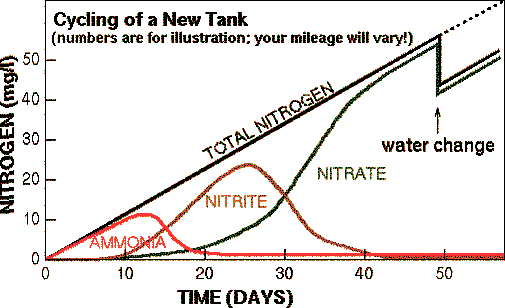
image via rusticgirls
In a freshwater aquarium you can add some flake food, wait a couple weeks, and then you can add fish. In the ocean there is much more involved than mechanical filtration. In fact, 70% of your aquariums filtration relies on the maturity of the live rock. A combination of bacteria, algae, and various invertebrates compose the “live” part of the rock. It takes quite a while to establish an ecosystem, even on a microscopic level. Without a proper understanding of the Marine Cycle, you will be in for a long term battle with parameters and algae. There are six main stages to a properly cycled tank. Follow this guide and you cannot mess up. You will need your basic test kit to test the progress.
Stage 1: Ammonia Cycle
Ammonia is the first thing that forms when something rots. It is a waste product in nearly all creatures as well. Instead of using a fish to start the cycle just use some food. Anything that is all natural and uncooked works just fine. Table shrimp that is uncooked works great. Drop it on the sand so it is in view. The shrimp should begin to rot within a couple hours or more. Let this shrimp rot until it is completely gone. If you are curious what your ammonia levels are, go ahead and take some tests. Keep track of the results as the shrimp rots. The smaller the food gets the more ammonia should be present in your water column and pretty soon should be off the charts. This will stay high for a while, but then start to drop. As soon as the ammonia starts to drop you will see a rise in Nitrite, you are now on the next stage.
Stage 2: Nitrite Cycle
Ammonia when broken down by bacteria becomes Nitrite, which is still a toxin. As your Nitrites rise your Ammonia will drop, drop, and keep dropping as long as you haven’t added any animals. Keep up with testing to observe your progress. Eventually your Ammonia will be very low and your nitrites will peak out until it starts feeding a different type of bacteria that turns it into Nitrates. Once your first signs of Nitrates are seen you are on the next stage.
Stage 3: Nitrate Cycle
Nitrates are removed within the live rock deep inside in all of the deep pours. This hidden bacteria consumes the nitrate and creates nitrogen gas as a byproduct. The nitrogen gas rises in the water column and escapes into the air. When one gas leave, another enters. Oxygen is then infused into the water. After the Nitrates start to dissipate your oxygen will increase and you will be ready for the intermission:
Intermission:
You are not done yet! You may have cultivated a nice crop of groovy bacteria and your water may be clean as can be, but, there are still 3 more stages to the cycle process before you can start your stocking. Take this time to consume all of which you have already done. The next 3 stages often put fear into the eyes of many newcomers. These are perfectly natural and are partially a representation of how the earth became an oxygen rich planet. Before there was any oxygen breathing organisms, there was the evolution of Cyanobacteria. This is a photosynthetic bacteria that creates Oxygen as a byproduct. There are several colors, but the commonality is that it is like a slime. The Cyanobacteria spread over a vast area and the atmosphere became oxygen rich like we breath today, without the smog. Cyanobacteria is responsible for life as we know it. The same applies to the reef. Now that your mind has been blown you may move on to the next stage of the cycle.
Pre-Algae Cycle:
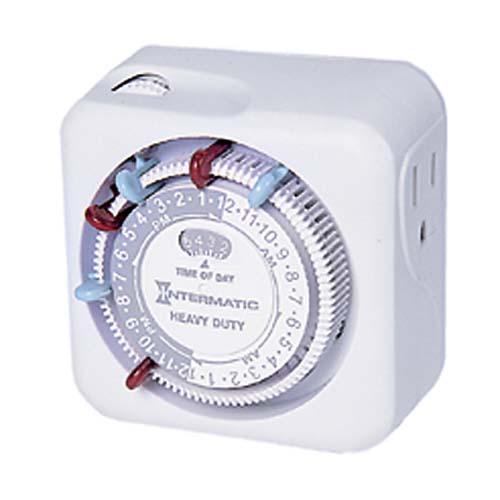
If your lights have not been setup yet do so now. Set your timers as you would for a reef tank. Anywhere from 6-12 hours is a good amount of time. Set the photoperiod to be on during the hours you will be viewing the tank most. If you work 2nd shift it is OK to have the lights come on after you get home from work or when you wake up in the morning. As long as there is not a supply of sunlight near the tank you wont have a long term battle with algae.
Stage 4: Diatoms
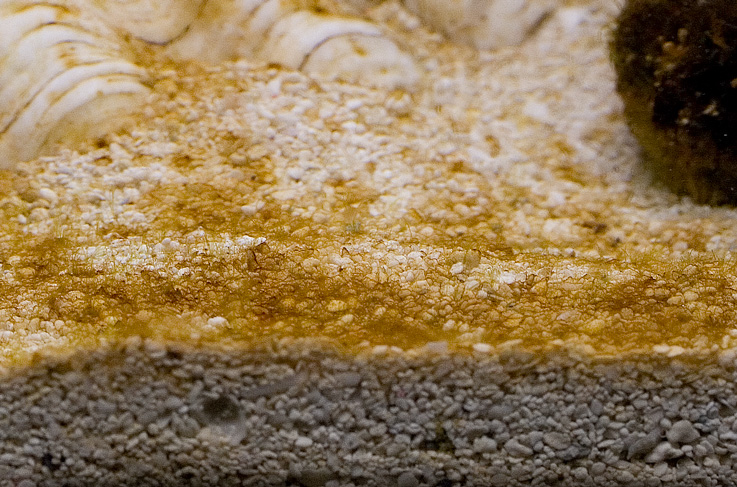
diatom algae image via reef2reef member Steven R
Diatoms are a brown dusty life form that consumes silicates. There is no avoiding Diatoms during their initial bloom. Leave it be. Let it go crazy. Before you know it, the brown stuff will soon start to change colors. Generally red, this is the start of the next stage!
Stage 5: Cyanobacteria
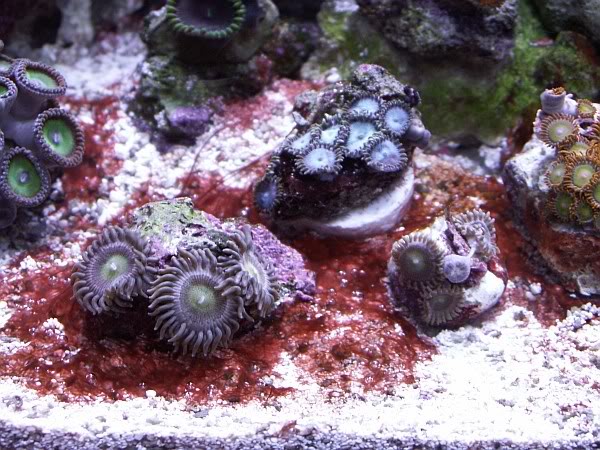
cyanobacteria image via reef2reef member murfman
Cyanobacteria will now begin its course. Again you will let the slime just do its thing. This will be the nastiest of the stages. Cyanobacteria can gross some people out, especially if they catch a whiff of it. It is best to leave it be. It will start to clear up eventually. The clearing of the slime makes way for yet another stage.
Stage 6: Green/Brown algae
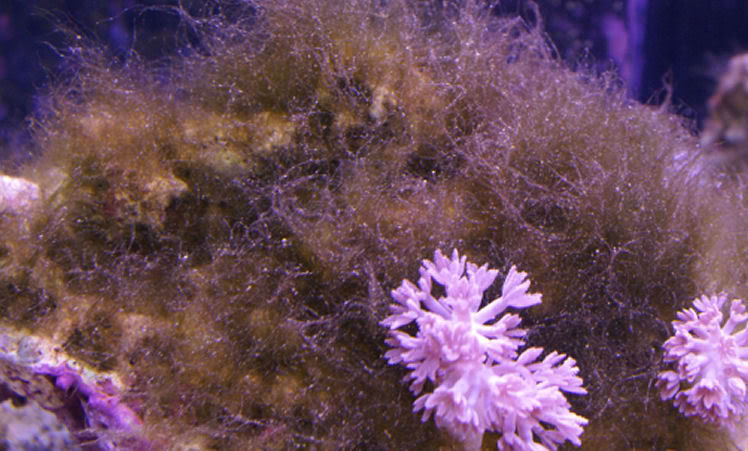
hair algae image via reef2reef member johnmaloney
If you have made it this far, give yourself a round of applause. This is the final “battle” of the cycle process. When the slime is gone you will see your first signs of plant life, algae! Green Hair algae is usually the type that you see, but some other types have been known to occur. This stuff will grow like mad. At this point you are ready to move on to the next phase.
The cycle is a long process in terms of hobbies. Find yourself a good rhythm for testing. Get yourself in the habit of staring for long periods of time. Practice observation by watching as life forms start taking foot in the aquarium. You will see things from dust sized particles to worms that reach a foot long. There really is no telling what could form in your tank. This is a great time to prepare for the animals you will get. Knowing how to describe things and being able to correctly test the water will help you get the information you need. Your parameters are perfect now. You are now ready to move on to the next section. You should actually study the next section during your cycle, since you will have quite a bit of time on your hands with all that waiting.
Cycles can be artificially induced, but it is always preferred to use as little foreign liquids as possible. Another thing you can do during the cycle is preparing your clean up crew and first fish, but be prepared to keep them quarantined for a prolonged time since the cycle is unpredictable.
Good luck
I'm getting a water change from a friend. and I'm going to add 20 to 25 galling of new water. and then going to see what all my parameters look like for a few days. but I will do the shrimp also. to help the cycle along. and I need to pay dues to some one...Excited for you man!
Whats your plan to initiate the cycle?
Im a fan of a "natural" method - a small piece of shrimp in a mesh bag, and time.
Most these days however try to hasten the process by adding bacteria and ammonia.
IMO, you might get a better variety of bacteria faster by doing the latter, but, in the end, you get there regardless.
....and I need to pay dues to some one...
Don't sweat dues. The years almost up. Come to a meeting. Get to know some folks. Maybe you can meet some members at the ETRC swap. Bring Lawton with ya! We need to get him to join as well. LOL
@KJ. thank you I had saw it in another thread and saved it to my clipboard on my phone.
is it October 1. thanks for all the help. you guys are full of knowledge
At this point your tank is running, your rocks and sand are in place, your powerheads are positioned, and your filtration has been fine tuned. This is the part that is most important to the well being of your tank. You cannot skip this step or your aquarium will never stop cycling. This can take up to 6 months before you can add any corals. Don’t fret. There is still plenty to do and see! The cycle is a very interesting thing to watch.
- Start the cycle: DO NOT ADD LIVE ANIMALS. All you need is a pinch of fish food or an uncooked table shrimp. The table shrimp works because you can monitor its progress as it rots.
Section 5: The Cycle

image via rusticgirls
In a freshwater aquarium you can add some flake food, wait a couple weeks, and then you can add fish. In the ocean there is much more involved than mechanical filtration. In fact, 70% of your aquariums filtration relies on the maturity of the live rock. A combination of bacteria, algae, and various invertebrates compose the “live” part of the rock. It takes quite a while to establish an ecosystem, even on a microscopic level. Without a proper understanding of the Marine Cycle, you will be in for a long term battle with parameters and algae. There are six main stages to a properly cycled tank. Follow this guide and you cannot mess up. You will need your basic test kit to test the progress.
Stage 1: Ammonia Cycle
Ammonia is the first thing that forms when something rots. It is a waste product in nearly all creatures as well. Instead of using a fish to start the cycle just use some food. Anything that is all natural and uncooked works just fine. Table shrimp that is uncooked works great. Drop it on the sand so it is in view. The shrimp should begin to rot within a couple hours or more. Let this shrimp rot until it is completely gone. If you are curious what your ammonia levels are, go ahead and take some tests. Keep track of the results as the shrimp rots. The smaller the food gets the more ammonia should be present in your water column and pretty soon should be off the charts. This will stay high for a while, but then start to drop. As soon as the ammonia starts to drop you will see a rise in Nitrite, you are now on the next stage.
Stage 2: Nitrite Cycle
Ammonia when broken down by bacteria becomes Nitrite, which is still a toxin. As your Nitrites rise your Ammonia will drop, drop, and keep dropping as long as you haven’t added any animals. Keep up with testing to observe your progress. Eventually your Ammonia will be very low and your nitrites will peak out until it starts feeding a different type of bacteria that turns it into Nitrates. Once your first signs of Nitrates are seen you are on the next stage.
Stage 3: Nitrate Cycle
Nitrates are removed within the live rock deep inside in all of the deep pours. This hidden bacteria consumes the nitrate and creates nitrogen gas as a byproduct. The nitrogen gas rises in the water column and escapes into the air. When one gas leave, another enters. Oxygen is then infused into the water. After the Nitrates start to dissipate your oxygen will increase and you will be ready for the intermission:
Intermission:
You are not done yet! You may have cultivated a nice crop of groovy bacteria and your water may be clean as can be, but, there are still 3 more stages to the cycle process before you can start your stocking. Take this time to consume all of which you have already done. The next 3 stages often put fear into the eyes of many newcomers. These are perfectly natural and are partially a representation of how the earth became an oxygen rich planet. Before there was any oxygen breathing organisms, there was the evolution of Cyanobacteria. This is a photosynthetic bacteria that creates Oxygen as a byproduct. There are several colors, but the commonality is that it is like a slime. The Cyanobacteria spread over a vast area and the atmosphere became oxygen rich like we breath today, without the smog. Cyanobacteria is responsible for life as we know it. The same applies to the reef. Now that your mind has been blown you may move on to the next stage of the cycle.
Pre-Algae Cycle:

If your lights have not been setup yet do so now. Set your timers as you would for a reef tank. Anywhere from 6-12 hours is a good amount of time. Set the photoperiod to be on during the hours you will be viewing the tank most. If you work 2nd shift it is OK to have the lights come on after you get home from work or when you wake up in the morning. As long as there is not a supply of sunlight near the tank you wont have a long term battle with algae.
Stage 4: Diatoms

diatom algae image via reef2reef member Steven R
Diatoms are a brown dusty life form that consumes silicates. There is no avoiding Diatoms during their initial bloom. Leave it be. Let it go crazy. Before you know it, the brown stuff will soon start to change colors. Generally red, this is the start of the next stage!
Stage 5: Cyanobacteria

cyanobacteria image via reef2reef member murfman
Cyanobacteria will now begin its course. Again you will let the slime just do its thing. This will be the nastiest of the stages. Cyanobacteria can gross some people out, especially if they catch a whiff of it. It is best to leave it be. It will start to clear up eventually. The clearing of the slime makes way for yet another stage.
Stage 6: Green/Brown algae

hair algae image via reef2reef member johnmaloney
If you have made it this far, give yourself a round of applause. This is the final “battle” of the cycle process. When the slime is gone you will see your first signs of plant life, algae! Green Hair algae is usually the type that you see, but some other types have been known to occur. This stuff will grow like mad. At this point you are ready to move on to the next phase.
The cycle is a long process in terms of hobbies. Find yourself a good rhythm for testing. Get yourself in the habit of staring for long periods of time. Practice observation by watching as life forms start taking foot in the aquarium. You will see things from dust sized particles to worms that reach a foot long. There really is no telling what could form in your tank. This is a great time to prepare for the animals you will get. Knowing how to describe things and being able to correctly test the water will help you get the information you need. Your parameters are perfect now. You are now ready to move on to the next section. You should actually study the next section during your cycle, since you will have quite a bit of time on your hands with all that waiting.
Cycles can be artificially induced, but it is always preferred to use as little foreign liquids as possible. Another thing you can do during the cycle is preparing your clean up crew and first fish, but be prepared to keep them quarantined for a prolonged time since the cycle is unpredictable.
Good luck
Ok so I have to wait all the way till I get the green hair algae before I add any type of clean up crew, corals, or fish??? I guess it just seems like a long time to wait. I would have thought that the cleanup crew would help eliminate the hair algae and the Cyanobacteria would still form with them in the tank. or am I missing something???
- Joined
- Jun 11, 2015
- Messages
- 808
- Reaction score
- 528
Once your passed all the stages of the cycle amonnia nitrite and nitrate your good to go. But I'd wait at a minimum of six weeks for sps or anemones. Better to wait a full year for those because of water parameter swings and just learning water chemistry and dosing.
Ideally, IMO, there will indeed be algae and stuff before you add the clean-up-crew (CUC). Thus the name; they need something to clean up, i.e. food.
It's an ugly part of the process, but necessary/beneficial. They even call this phase "the uglies".
The CUC as the very first additions basically take the place of the rotting shrimp, ultimately producing ammonia to keep the cycle, or wheel, going.
Later, the first fish result in even more ammonia, and the wheel keeps spinning, faster so-to-speak.
The challenge is to go slow enough adding life forms that there is never any detectable/excess ammonia; that there are enough bacteria to consume all that is being produced.
There must be a continual balance, and adding too much too fast can be catastrophic, as only the bacteria like ammonia. Its poison to all else. Same with nitrite.
A wise man once told me "never pray for patience". This is because there's only one way to learn it - the hard way. So, better to just be patient, willfully, than be taught to be patient. Reefers must be very patient. So yeah, "wait all the way" to the uglies. [emoji6]
It's an ugly part of the process, but necessary/beneficial. They even call this phase "the uglies".
The CUC as the very first additions basically take the place of the rotting shrimp, ultimately producing ammonia to keep the cycle, or wheel, going.
Later, the first fish result in even more ammonia, and the wheel keeps spinning, faster so-to-speak.
The challenge is to go slow enough adding life forms that there is never any detectable/excess ammonia; that there are enough bacteria to consume all that is being produced.
There must be a continual balance, and adding too much too fast can be catastrophic, as only the bacteria like ammonia. Its poison to all else. Same with nitrite.
A wise man once told me "never pray for patience". This is because there's only one way to learn it - the hard way. So, better to just be patient, willfully, than be taught to be patient. Reefers must be very patient. So yeah, "wait all the way" to the uglies. [emoji6]
@CastAway I made the mistake of praying for patience. so I may be out of luck.

this sucks now a bulk head is leaking
this sucks now a bulk head is leaking
Gasket goes on the wet side; hand tight only, no wrenching them.
If you're hard plumbing directly to the bulkhead, make sure the pipe is supported otherwise, and not putting any pressure on the bulkhead. Pressure over time will deform the gasket unevenly, and breaks in the glass occur commonly as a result.
Gasket goes on the wet side; hand tight only, no wrenching them.
This is not always true. Gasket goes on the opposite side of the nut - no ifs and buts. Depending on the way the bulkhead is installed, the gasket can end up either on the wet side or dry side. As long as you install it on the opposite side of the nut you should be fine, everything else being in good condition.
What you weren't waiting at the door for the delivery.it's always a good morning when you wake up to a Marine Depot box sitting by the door!!!
This is not always true. Gasket goes on the opposite side of the nut - no ifs and buts. Depending on the way the bulkhead is installed, the gasket can end up either on the wet side or dry side. As long as you install it on the opposite side of the nut you should be fine, everything else being in good condition.

I was passed out worked that night. but got up way early like only 4 hrs sleepWhat you weren't waiting at the door for the delivery.
Similar threads
- Replies
- 1
- Views
- 146
- Replies
- 24
- Views
- 468
- Replies
- 853
- Views
- 14,171



















